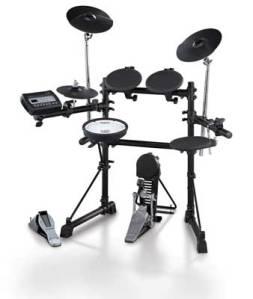Everything, it seems, has gone digital these days: music, games, keyboards – even how we pay for our morning coffee. While everything is evolving into the digital era, can electronic versions truly make the original product better? Looking at this from the perspective of a percussion student, performer or teacher, we ask: Do electronic drum kits really measure up to its acoustic predecessors?
Electronic drum kits have come a long way since their introduction to the music industry in 1976. In recent years, newer drum kits have addressed many of the shortcomings of early electronic drums. Basic entry-level units aside, the more professional kits, built from brands like Yamaha and Roland, have been geared toward creating a sound and playing experience that is nearly indistinguishable from the traditional acoustic kit. With focus on high quality digital sounds (these kits can simulate effects like muffling, microphone position and ambient acoustic), multiple triggers, realistic hi-hats and multiple outputs, these features go a long way in making these sets more enjoyable to play.
So what are the advantages of playing and learning on an electronic kit?
- Little noise, if desired – the drummer can adjust the volume to fit their surroundings, or use headphones for nearly silent practice. No more need for pads or mesh heads to dull the sound of acoustic drums.
- More compact design which makes these kits an ideal solution for small rooms and not a nightmare to move once assembled.
- Most electronic kits have the ability to simulate the sound of different kits, like a vintage jazz, powerful rock or spunky Latin.
- They create easy wirings for performances and gigs, by using a line-out or MIDI connection. No complicated microphone set ups required! Same benefit applies for recording sessions as well.
- Most include a built-in metronome and practice tracks, which is great for students.
- For band rehearsals, electronic drums can be lowered to a volume to match the rest of the group, which helps a great deal in cramped practice spaces or small groups.
- No risk of electronic drums becoming scratched or warped in if treated badly or left somewhere damp.
- No need to tune an electronic kit!
Next, we’ll take a look at the electronic kit’s disadvantages:
- Most drummers will agree that electronic kits lack the authentic feel or sound the same as an acoustic one. While technology continues to improve on this, it’s difficult to replicate the sound and feel of real drums, cymbals and hi-hats, even with a top-of-the-line electronic kit.
- Some electric drum kits (though usually basic models) do not include pedals, but supplied with trigger pads which are hard to play at fast tempos and insensitive to the light touch.
- Electronic kits do require external amplification from a specialized drum amplifier/monitor, which is an added cost.
- Some electric drum kits have very limited positioning options, making it difficult for all ages and sizes to play comfortably.
In the end, which is better? The answer likely lies in your situation and ultimate goal as a percussionist. For students learning the ropes, an electronic kit provides all the necessary staples to get started, and parents won’t have the headache of constant noise during practice hours. Professional musicians may favor acoustic kits because of their sound, feel and visual appeal, especially if this is what they are used to!

